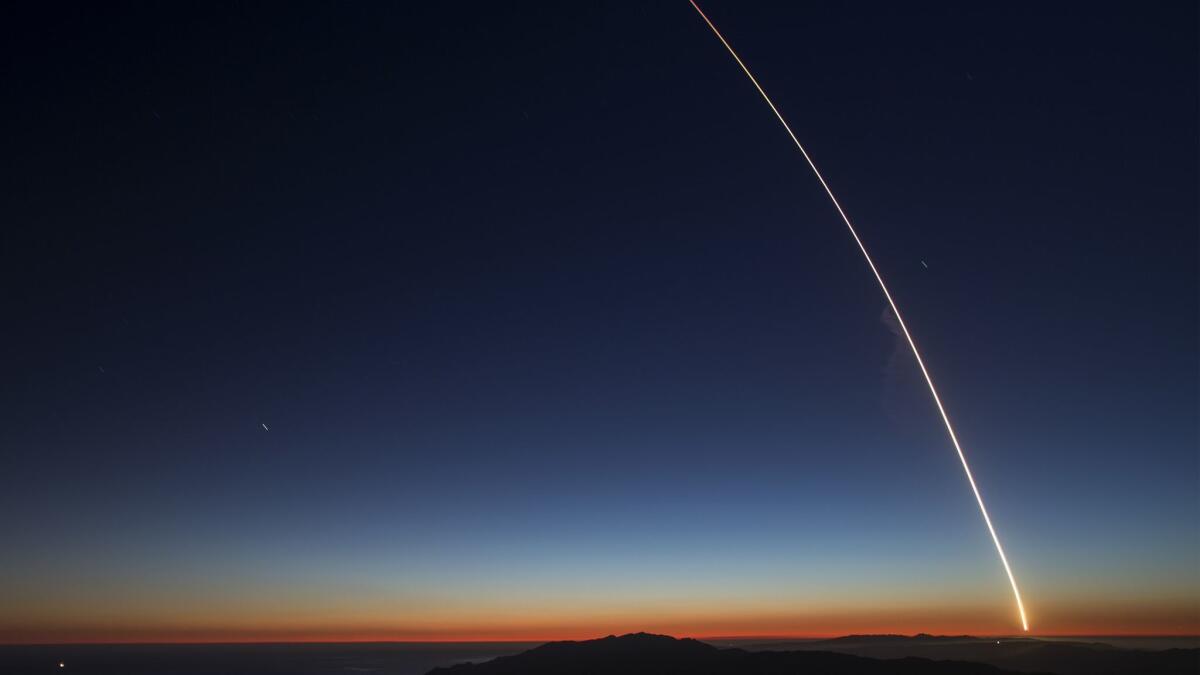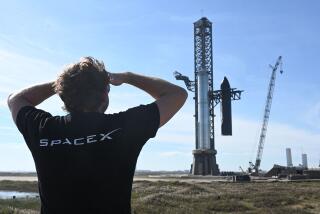SpaceX gets FCC approval to operate a second satellite constellation for broadband internet

- Share via
SpaceX’s plans to offer broadband internet took another step forward Thursday as the Federal Communications Commission approved the company’s application to operate an additional constellation of thousands of small satellites in very-low-Earth orbit.
Chief Executive Elon Musk has said the proposed satellite constellation could provide cheaper internet access, especially in more rural areas that are hard to service through land-based networks. So far, the Hawthorne company has launched only two demonstration satellites, and SpaceX President Gwynne Shotwell said this year that the company still had “much to do with this complex undertaking.”
In the meantime, several other companies — including Arlington, Va.-based OneWeb — are also racing to pump out satellites and start launching their own constellations to provide broadband internet access.
The newly approved constellation, together with a previously approved one, is expected to enable SpaceX to provide “diverse geographic coverage” and the capacity to support broadband and communications services in the United States and around the world, according to an FCC fact sheet.
In its proposal approved Thursday, SpaceX says it plans to launch 7,518 satellites that would operate at altitudes ranging from 205 to 215 miles above the Earth. Those satellites would use frequencies in what is known as the V-band to transmit data back to Earth.
That constellation is expected to be used in tandem with the one approved by the FCC in March. As described then, the first constellation would be positioned in a higher orbit, 714 miles above Earth, use different frequencies and initially comprise 4,425 satellites. SpaceX, whose full name is Space Exploration Technologies Corp., launched the first two demonstration satellites for that network in February, and the company has said they are functioning.
The FCC has mandated that SpaceX begin operation of at least half of the satellites in the initial constellation by March 29, 2024, or stop adding satellites. SpaceX has said it plans to launch its first batch of satellites before the end of next year.
To “accelerate” its deployment schedule, the company filed a separate request with the FCC this month asking to decrease the number of satellites in the initial constellation by 16. It also asked the FCC for permission to change the planned location of 1,584 satellites: They had been authorized to operate at the higher orbit, but SpaceX wants instead to put them at a lower orbit of 342 miles above Earth. That would “simplify the spacecraft design” and aid with orbital debris removal at the end of the satellites’ life, the company said.
That request has not yet been addressed by the FCC and must go through a public comment period.
Last month, reports said Musk fired some of the senior managers on the satellite constellation project, known as Starlink, at SpaceX’s office in Redmond, Wash., because of disagreements over the speed of developing and testing the satellites.
Also on Thursday, SpaceX launched a satellite from Kennedy Space Center in Florida. That satellite, belonging to Qatar, is set to provide secure communications for businesses and governments in the Middle East and North Africa. The launch was SpaceX’s 18th of the year, which equals last year’s total.
Twitter: @smasunaga
UPDATES:
1:35 p.m.: This article was updated with SpaceX’s Thursday launch in Florida.
This article was originally published at 10:40 a.m.
More to Read
Inside the business of entertainment
The Wide Shot brings you news, analysis and insights on everything from streaming wars to production — and what it all means for the future.
You may occasionally receive promotional content from the Los Angeles Times.











